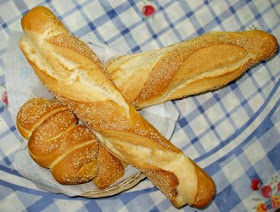The month of December is the richest of festivities, traditions and gastronomy.
The shops are already adorned with the Christmas decorations and cake shops are already full of sweets and biscuits.
The streets of the city are enriched by the colored lights (l'archi) of various types (simple threads of light, or wooden structures in the shape of stars, circles, flower), by white gold angels (which remember the sculptures of Serpotta), in expectation of seeing the big Christmas tree in front of Theatre Politeama, or see the steps of the Teatro Massimo covered by a red carpet of "Christmas stars", and palm trees illuminated by golden lights that make suggestive night.
This year, probably will be a climate of austerity because of the recession, certainly people will spend less, but perhaps curb excessive consumerism is also positive (of course if this will be a chance to revive other values, such as the rediscovery of self and others, of the value of diversity, peace, something deeper and not the ephemeral things that has filled television and the heads of people in recent years). I hope the fear of the future (fed every day by mass media) that turns easily into individualism, racism, closure, do not take the upper hand and that outweighs the will to live, to love and then even laugh and why not ... eat.
It 'also why in this particular year, it is important to celebrate and have fun with a few things. And the kitchen poor (but at the same time cheerful)of Palermo helps raise the mood without spending too much.

Again the opportunity is good to reunite families at the table.
The evening's eve (December 7) is the day when the people starts to play cards and bingo, which will last throughout the month and will conclude with the epiphany.
But the people of Palermo does not play on an empty stomach ... the dishes of this occasion is "Sfincione" and especially "Fried Cod or with raisins."
For lunch the next day usually eats "ANELLETTI o furnu"
"Lasagne cu sucu ri cutini ", or pork sausage with the sauce. Perhaps to sanction the arrival of cold with these foods more fat. The sweets to celebrate "A Maruonna" are many and very attractive, the Reginella (dry biscuits covered with sesame), "the Mustazzuola" (biscuit with honey ), "Buccellatini" and "u Cucciddatu tunnu". These are biscuits, stuffed figs, almonds, raisins.
We prepared "the Sfinci" home-made (leavened dough, fried in hot oil and then sprinkling of sugar), other than "Sfinci of San Giuseppe" which are stuffed with ricotta and you eat for the day which celebrates the namesake saint.
The feast that follows is Saint Lucia (on 13 December). Throughout the day "is not possible" eat bread and pasta, because the legend says that could become blind (during the month I will have more time to tell stories, legends and recipes). The people of Palermo have not taken literally the idea of penance or sacrifice, and so have invented a range of delicacies to can give up pasta and bread in particular .... For having to replace the breakfast with bread and milk, prepared rice soup with broccoli (cauliflower) or boiled vegetables, "patatevugghiute" (boiled potatoes)," Allessi "(boiled chestnuts) or even "Panelle and cazzilli”. For lunch and dinner the Arancino with meat or “al burro” (with ham and cheese), is great fun to prepare at home that often involves all the family members. "Grattò" ( potatoes with meat sauce and peas), and panelle crocchè and "patati a spizzatinu" (stewed potatoes).
And especially not miss the sweet, ”La Cuccìa”.
The Cuccìa was originally a very simple dish and poor, which was boiled wheat and seasoned with olive oil.
In Palermo, the original “Cuccìa” has given rise to a new sweet, with wheat boiled, cream cheese, candied and chocolate flakes.
Christmas is also in Palermo the most important festival of the year.
Families have already decorated the tree (there are two schools of thought, one that will decorate the tree on December 8 "Pa 'Maruonna", the second on 13 for Saint Lucia), there are people who make the crib.
The gifts are ready and the food (which is beginning to prepare the day before).
On the morning of Christmas (or the night of the eve) usually the people goes to Church (even those who do not go there throughout the year).
And then returned home will start the eating.
The choice is wide, it can vary from meat to fish, and now has been "contaminated" by more modern dishes and other sources, but here I only followed the traditional cuisine.
Starting from the starters: "U'Piattinu" with all types of cheeses and cold cuts (pizzami), "L’ Arenga salata" with herring, orange, pepper and onion oil, "U ficatu ri sette cannuola " (pumpkin in sweet and sour), "Oliva bianche cu' l’accia (olives with celery), “verdure a pastetta "(broccoli, artichokes, cardoons etc, in batter and fried)," Sardi a beccaficu " etc.
As first courses, "A pasta o furnu", "A pasta chi vrocculi arriminata."
As main courses "Brociolone" or "Farsu magru" (meat roll stuffed with breadcrumbs, pine nuts, raisins, cold cuts, boiled eggs), “Pisci spada ‘a ghiotta” (swordfish).
And many desserts including "cannoli", "Turruni", "Cucciddatu", "Petra fennula", including various pastries "Sciù" (BIGNE with ricotta), "Cassatine", "Cannulicchi", ficu sicchi" (figs dried),
"passuluna" (figs boiled) and scacciu (pumpkin seeds, chick peas, peanuts).
The same dishes are also prepared for the following day, Boxing Day and New Year lunch.
The night of the end of the year, someone goes outside home
You can then make a walking to Politeama, where there is the New Year concert.





























